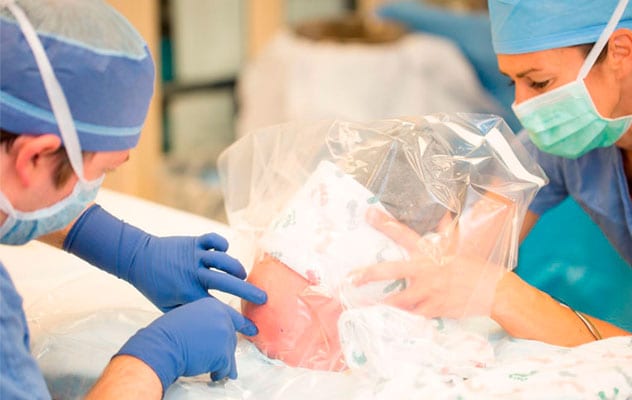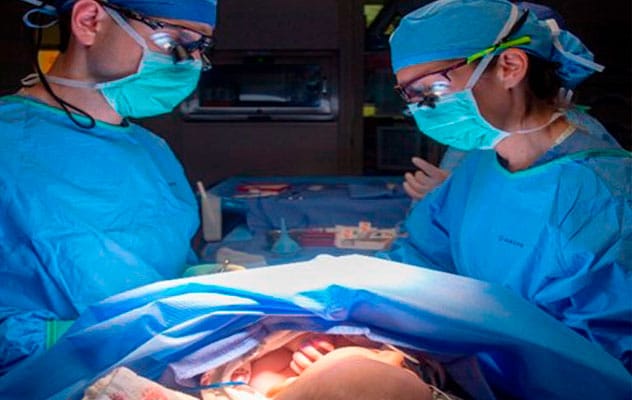Feb. 22, 2022
"Your baby needs surgery." Those words can trigger immediate stress and fear for parents, particularly when they're thinking of their baby having anesthesia. These fears have been supplemented by data citing concern about neurotoxicity secondary to repeated or prolonged use of general anesthetics in babies and children, followed in 2016 by FDA-mandated warnings to be added to labels of general anesthetic and sedative drugs to inform the public about this potential risk.
Though studies to better delineate this link are ongoing, members of the pediatric urology team at Mayo Clinic worked with their pediatric anesthesia colleagues to pursue alternative anesthesia options to avoid general anesthesia for select patients undergoing pediatric urologic procedures.
Although spinal anesthesia has been used since the early 1900s, it hasn't been adopted as common practice as a standalone anesthesia modality for pediatric surgical procedures. After hearing a pediatric anesthesiologist give a talk about the protocol at a national conference, Candace F. Granberg, M.D., a pediatric urologist at Mayo Clinic in Rochester, Minnesota, approached him to discuss the process of implementing such a program.
Spinal anesthesia program development
Dr. Granberg then partnered with Dawit T. Haile, M.D., Pediatric Anesthesiology division chair at Mayo Clinic in Minnesota, to start a program. "We were very intentional in developing our spinal anesthesia protocol," says Dr. Granberg. "We wanted to be sure it was safe and effective, that logistically we had appropriate surgical candidates, and that we had the right operating room team and workflow."
The spinal anesthesia program started with shorter procedures such as circumcision. It has since expanded to include orchiopexies, hernia and hydrocele repairs, hypospadias repairs, cutaneous vesicostomy, and neonatal testicular torsion cases.
"We are offering spinal anesthesia to parents of all of our patients under 12 months of age undergoing these procedures," says Patricio C. Gargollo, M.D., a pediatric urologist at Mayo Clinic in Minnesota. "Any time we will be making an incision below the umbilicus, we know we can offer spinal anesthesia."
"Importantly, the analgesic effects of the spinal anesthesia are long lasting, obviating the need for supplemental opioids for pain control, which is germane to the overarching goal of opioid stewardship in the pediatric population," notes Dr. Granberg.
The program team published its experience implementing the protocol in Pediatric Anesthesia in 2020, documenting successful use of spinal anesthesia for urologic procedures. Compared with children having the same procedures performed under general anesthesia, pediatric patients who received spinal anesthesia had shorter anesthesia time, surgical time and recovery room length of stay.
In 2021, the program team presented its data on prolonged spinal anesthesia (longer than 60 minutes) for urologic procedures at The Societies for Pediatric Urology Fall Congress; they reported successful completion of surgery under spinal anesthesia only (no ancillary anesthesia modalities) in 95% of patients.
موضع التخدير النخاعي

موضع التخدير النخاعي
توضح الصورة موضع التخدير النخاعي الذي سيُحقَن فيه المخدر العام الأساسي لإجراء عملية جراحية في المسالك البولية لطفل رضيع.
رضيع يخضع لعملية ترميم الإحلال التحتي

رضيع يخضع لعملية ترميم الإحلال التحتي
صورة تبين رضيع يخضع لعملية ترميم الإحليل التحتي تحت تأثير تخدير نخاعي مع وضع لهَّاية في فمه (بدلاً من الأنبوب الرغامي).
The program team continues to prospectively collect data. "We've noted decreased operating room turnover times, which has implications for significant cost savings," says Dr. Gargollo. "Moreover, particularly in light of the ongoing COVID-19 pandemic and other ever-present respiratory viruses in the pediatric population, spinal anesthesia is an excellent way to avoid airway manipulation and its associated risk of laryngospasm and pulmonary sequelae."
Parents have been extremely happy to have the option of spinal anesthesia offered for their baby's surgery. "You can see the relief in their faces when they hear that their baby can avoid general anesthesia," says Anna B. Strand, APRN, C.N.P., M.S.N., a Pediatric Urology nurse practitioner at Mayo Clinic in Minnesota. "In fact, we have had families travel from quite a distance specifically for our spinal anesthesia program — it is that important to families."
"Collaboration and communication between surgeons and anesthesiologists are absolutely key to implementing a successful spinal anesthesia program," Dr. Granberg notes. "We are grateful to have such an excellent working relationship among colleagues at Mayo Clinic as to be able to offer spinal anesthesia and avoid unnecessary drugs with unknown long-term effects. When it comes to anesthesia and medications in infants and children, less is more."
For more information
Handlogten K, et al. Implementation of a spinal anesthesia and sedation protocol that reliably prolongs infant spinal anesthesia: Case series of 102 infants who received spinal anesthesia for urologic surgery. Pediatric Anesthesia. 2020;30:1355.
Jefferson F, et al. Spinal anesthesia in infants undergoing urology surgery >60 minutes. Presentation at: The Societies for Pediatric Urology Fall Congress; 2021; Miami.
Refer a patient to Mayo Clinic.